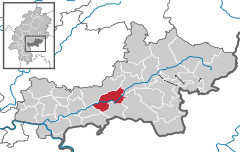Gelnhausen
Town in Hesse, Germany From Wikipedia, the free encyclopedia
Town in Hesse, Germany From Wikipedia, the free encyclopedia
Gelnhausen (German pronunciation: [ɡɛlnˈhaʊ̯zn̩] ) is a town, and the capital of the Main-Kinzig-Kreis, in Hesse, Germany. It is located approximately 40 kilometers east of Frankfurt am Main, between the Vogelsberg mountains and the Spessart range at the river Kinzig. It is one of the eleven towns (urban municipalities) in the district. Gelnhausen has around 22,000 inhabitants.
This article includes a list of general references, but it lacks sufficient corresponding inline citations. (April 2013) |
Gelnhausen | |
|---|---|
 View of Gelnhausen with the Marienkirche | |
Location of Gelnhausen within Main-Kinzig-Kreis district  | |
| Coordinates: 50°12′N 09°10′E | |
| Country | Germany |
| State | Hesse |
| District | Main-Kinzig-Kreis |
| Subdivisions | 6 districts |
| Government | |
| • Mayor (2017–23) | Daniel Christian Glöckner[1] |
| Area | |
| • Total | 45.18 km2 (17.44 sq mi) |
| Highest elevation | 312 m (1,024 ft) |
| Lowest elevation | 180 m (590 ft) |
| Population (2022-12-31)[2] | |
| • Total | 23,679 |
| • Density | 520/km2 (1,400/sq mi) |
| Time zone | UTC+01:00 (CET) |
| • Summer (DST) | UTC+02:00 (CEST) |
| Postal codes | 63571 |
| Dialling codes | 06051 |
| Vehicle registration | MKK, GN, SLÜ |
| Website | www |

According to the Institut Géographique National from 1 January 2007 until July 2013 the geographic centre of the European Union was located on a wheat field outside the town.
Gelnhausen is located on the German Fairy Tale Route, a tourist route.
Imperial City of Gelnhausen Reichsstadt Gelnhausen | |||||||||||||
|---|---|---|---|---|---|---|---|---|---|---|---|---|---|
| 1170–1803 | |||||||||||||
| Status | Free Imperial City | ||||||||||||
| Capital | Gelnhausen | ||||||||||||
| Government | Republic | ||||||||||||
| Historical era | Middle Ages | ||||||||||||
• Founded by Frederick Barbarossa | 1170 | ||||||||||||
• Pledged to Ld Hanau | 1349–? 1170 | ||||||||||||
| 26 May 1349 | |||||||||||||
• Hohnstein share to Schwarzburg | 22 July 1431 | ||||||||||||
| 26 May 1435 | |||||||||||||
• Hanau extinct; share to Lgvt Hesse-Kassel | 28 March 1736 | ||||||||||||
• Palatinate share to Hesse-Kassel | 1746 1803 | ||||||||||||
• Hesse-Kassel raised to electorate | 1803 | ||||||||||||
| |||||||||||||


Gelnhausen was founded by Emperor Frederick Barbarossa in 1170, it is therefore nicknamed "Barbarossastadt". The place was chosen because it was at the intersection of the Via Regia imperial road between Frankfurt and Leipzig and several other major trade routes. Frederick had three villages connected by streets and surrounded by a wall. At the same time, Gelnhausen received town privileges and a Kaiserpfalz was erected on an island of the Kinzig river. The emperor also granted trade privileges like the staple right which forced traveling merchants to offer their goods in the town for three days.
Hence Gelnhausen initially was a thriving trade town and head of a league of 16 towns of the Wetterau region. However prosperity came to an end already in 1326 when Emperor Louis IV gave the town in pawn to the counts of Hanau, redeemed shortly afterwards. In 1349 Count Günther von Schwarzburg received Gelnhausen from Emperor Charles IV for renouncing his claims as elected King of the Romans, in condominium with the counts of Hohnstein, who sold their share to Schwarzburg in 1431. Schwarzburg was acquired in 1435 by Elector Palatine Louis III and the Hanau, since raised to a county.
Repeated plundering in the Thirty Years' War as depicted by Hans Jakob Christoffel von Grimmelshausen in his novel Simplicius Simplicissimus made it nearly uninhabitable. In 1736, the extinction of the comital line of Hanau meant the condominium share was inherited by the Landgraviate of Hesse-Kassel, who acquired the Palatinate's share ten years later.
The varying lords made continued attempts to challenge Gelnhausen's imperial immediacy, it however formally remained a Reichsstadt. During the German Mediatisation of 1803 the city became a part of the Landgraviate of Hesse-Kassel, which was raised to an electorate and, after the Austro-Prussian War of 1866, was annexed by Prussia. At this time Gelnhausen had completely recovered, and with the Gründerzeit economic boom it became a centre of the German rubber industry.
During the Nazi era, Gelnhausen was reported judenfrei on November 1, 1938, by propaganda newspaper Kinzigwacht after its synagogue was closed and remaining local Jews forced to leave the town.[3]
From the 1930s Gelnhausen was a garrison town of the German Wehrmacht and, after World War II, of the United States Army. The US Army closed Coleman Kaserne in 2007.
In 1996, the town hosted the 36th Hessentag state festival.
Sights include:
Gelnhausen is twinned with:
Gelnhausen lies directly on the German autobahn A66. Gelnhausen station is located on the Kinzig Valley Railway, a major line between Frankfurt and Fulda. Regional services from Frankfurt to Fulda or Wächtersbach stop in Gelnhausen.
Like many American soldiers, in 1959 Colin Powell, then lieutenant of the 3rd Armored Division, served at Coleman Kaserne. A street was named after him. During the Second Gulf War, there was some discussion about renaming the street because of Germany's stance on the war. The mayor of Gelnhausen strongly objected.[citation needed]
Seamless Wikipedia browsing. On steroids.
Every time you click a link to Wikipedia, Wiktionary or Wikiquote in your browser's search results, it will show the modern Wikiwand interface.
Wikiwand extension is a five stars, simple, with minimum permission required to keep your browsing private, safe and transparent.